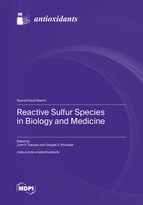Reactive Sulfur Species in Biology and Medicine
A special issue of Antioxidants (ISSN 2076-3921). This special issue belongs to the section "ROS, RNS and RSS".
Deadline for manuscript submissions: closed (31 May 2023) | Viewed by 25536
Special Issue Editors
Interests: hydropersulfides; hydrogen sulfide; nitroxyl; azanone; nitric oxide
Special Issue Information
Dear Colleagues,
Hydrogen sulfide (H2S) has emerged as an important cell-signaling molecule capable of regulating diverse physiological processes. However, the exact mechanisms of H2S signaling remain ill-defined. Emerging evidence shows that many biological effects initially ascribed to H2S may instead be due to other reactive sulfur species (RSS), including hydropersulfide (RSSH) and other higher order polysulfur species (RSSnH, RSSnR, HSnH, n >1). Importantly, these RSS are highly prevalent in biological systems, and emerging evidence shows that they likely have critical roles in several (patho)physiological processes. RSS have intriguing biochemical properties, such as the ability to modify protein cysteine residues and efficiently scavenge reactive oxygen species and electrophiles. Moreover, RSS donors have begun to demonstrate therapeutic potential in treating a wide range of disorders including cancer, neurological disorders, and cardiovascular disease. Nonetheless, the chemistry of RSS is complicated due to their reactive nature, and their accurate measurement in biological systems remains a challenge.
This Special Issue of Antioxidants will focus on studies that highlight recent advances in RSS chemical biology, including original research articles and reviews aimed at understanding the molecular mechanisms and physiological roles of RSS, methods that unambiguously measure the concentration and distribution of RSS in biological systems, and potential therapeutic applications of RSS donors.
We look forward to your contributions.
Prof. Dr. John P. Toscano
Dr. Vinayak S. Khodade
Guest Editors
Manuscript Submission Information
Manuscripts should be submitted online at www.mdpi.com by registering and logging in to this website. Once you are registered, click here to go to the submission form. Manuscripts can be submitted until the deadline. All submissions that pass pre-check are peer-reviewed. Accepted papers will be published continuously in the journal (as soon as accepted) and will be listed together on the special issue website. Research articles, review articles as well as short communications are invited. For planned papers, a title and short abstract (about 100 words) can be sent to the Editorial Office for announcement on this website.
Submitted manuscripts should not have been published previously, nor be under consideration for publication elsewhere (except conference proceedings papers). All manuscripts are thoroughly refereed through a single-blind peer-review process. A guide for authors and other relevant information for submission of manuscripts is available on the Instructions for Authors page. Antioxidants is an international peer-reviewed open access monthly journal published by MDPI.
Please visit the Instructions for Authors page before submitting a manuscript. The Article Processing Charge (APC) for publication in this open access journal is 2900 CHF (Swiss Francs). Submitted papers should be well formatted and use good English. Authors may use MDPI's English editing service prior to publication or during author revisions.
Keywords
- hydrogen sulfide
- hydropersulfide
- polysulfide
- reactive sulfur species








